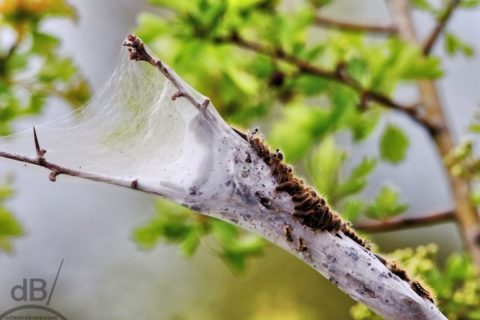As a keen photographer, I am always on the look out for odd and intriguing things to photograph. In the absence of birds other than skylarks and rooks along the St Ives to Cambridge guided busway I photographed what looked like a silky nest in a blackthorn/hawthorn bush. It was on the left-hand side of the walkway as you approach the Oakington stop (about 400m away in fact). And then another.

I posted the photo to Facebook and asked for comments (to be honest I hadn’t even noticed the caterpillars at the time I took the photo and only did so when I was “developing the print”. I had been musing on it being an immigrant funnel web spider’s nest or similar and keeping my distance.
Singing friend Jill Barrett suggested the caterpillars were those of the oak processionary moth (Thaumetopoea processionea). This species has been causing problems for oaks for a number of years, but it seems infestations were, until recent years, limited to London and environs. Graham Bellamy commented that it was more likely to be a Brown-tail moth given that the nest was growing on a thorn bush rather than an oak tree. This was later confirmed by a contact at the Forestry Commission.
If the Forestry Commission had said these were oak processionaries, that wouldn’t have been good news for our local oaks. It would also have been bad news for anyone who comes into contact with these caterpillars. They have myriad tiny hairs which if they touch skin or eyes or fragments are breathed in can sometimes cause serious inflammation [and irritation of skin, eyes, and lungs].
If you see one of these nests, stay well clear. Don’t try and remove it yourself even if there are no live caterpillars present, there will inevitably be toxic hairs and hair particles left behind. There are many species of hairy caterpillar that can cause similar health problems and there are others that damage different trees.
Here’s the science bit:
The oak processionary moth caterpillar hairs carry lots of soluble proteins, one of those extracted and identified in 1986 is found only in the hairs and causes a reaction on skin identical to that produced by contact with the hairs and so is assumed to be the causative toxin of the inflammatory response. Texier et al named this urticating protein thaumetopoein. It is, they explain, formed from two protein subunits and is present in large quantities in the glands producing the caterpillar's urticating hairs.
“Thaumetopoein: an urticating protein from the hairs and integument of the pine processionary caterpillar (Thaumetopoea pityocampa Schiff., Lepidoptera, Thaumetopoeidae)” by Lamy M, Pastureaud MH, Novak F, Ducombs G, Vincendeau P, Maleville J, Texier L. in Toxicon. 1986;24(4):347-356.